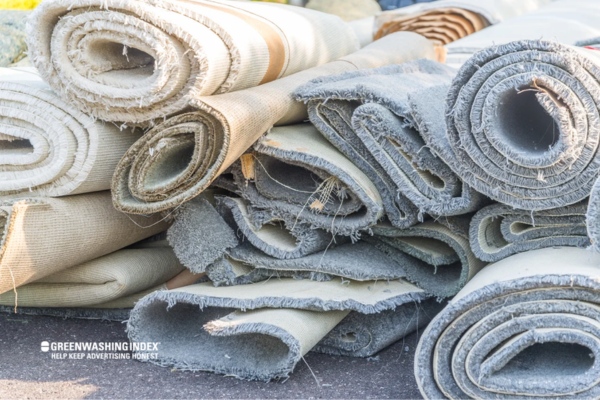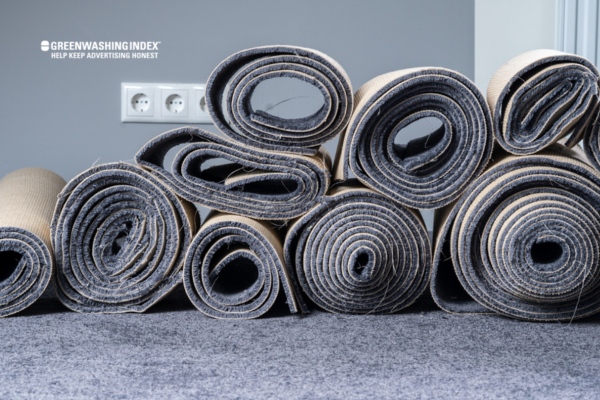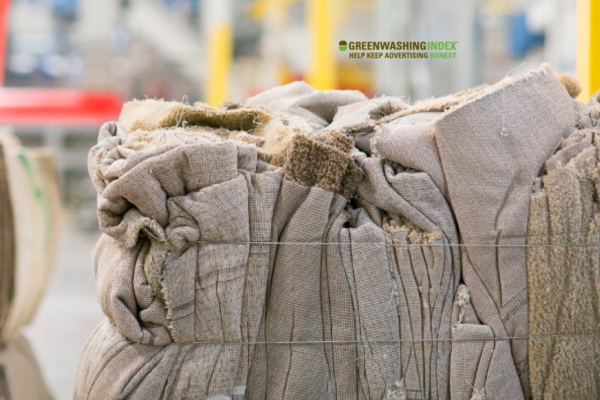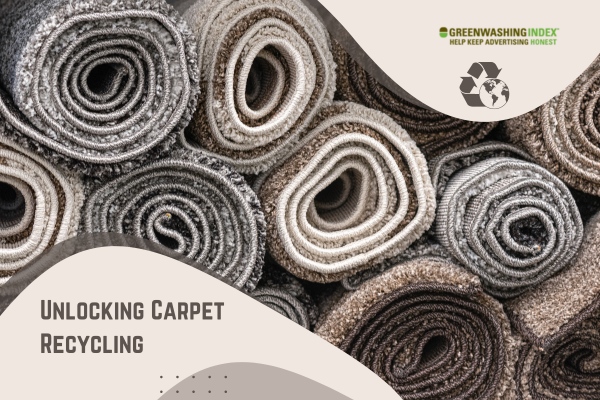Ever thought about the fate of your old carpet once it’s out of sight? Well, I did, and let me tell you, it’s nothing short of a jigsaw puzzle. Carpet recycling is not just about throwing away that old rug. It’s much more than that. It’s about waking up to eco-friendly flooring and going the extra mile for sustainable living – all through one single conscious choice.
Answering the question, “How to recycle carpets the right way?” depends on many factors. You may begin by separating various components like fibers or backing material from your carpet. Also, gain insights into different types of carpets, such as Nylon, Polyester, or Wool-based, and understand their specific recyclability options.
So, whether it’s giving that old treasure to local recycling centers or exploring online options – every bit counts towards constructing the circular economy for carpets.
Discover From Here:
- Eye-opening facts about carpet recycling
- Diverse approaches towards sustainable living
- The how-to guide on initiating carpet recycling
- Finding local and online resources for efficient disposal
- Surprising uses for recycled carpets in manufacturing & energy production
Understanding the Impact of Carpets
In our quest for sustainable living and making environmentally conscious choices, we often overlook certain aspects of our daily lives. One area that demands urgent attention is carpet recycling.

When I first looked into carpet recycling, I was staggered by the amount of waste that results from improperly disposed carpets. Each year, we discard millions of tons of carpets — most ending up in landfills or incinerated, releasing harmful greenhouse gases into the atmosphere.
Carpets are complex creatures crafted with multiple components and types of material, which each have their own environmental footprint. The process of creating a carpet requires resources and energy; it would be a shame to let all these go to waste when a carpet reaches its end-of-life stage.
Furthermore, if not recycled properly, carpets contribute to water pollution by leaching chemicals into the ground—a serious threat to both terrestrial and aquatic ecosystems. What’s worse is that this process translates directly into adverse health effects for people who rely on these sources for their drinking water supply.
Understanding this impact makes one realize that carpet recycling isn’t simply about repurposing old rugs—it’s about connecting dots within our ecosystem and ensuring we take steps toward creating a healthier planet for future generations.
Landfill Problems
The second issue at hand is landfill space. Once carpets reach their end-life stage, they are typically bulky items that occupy significant space in landfills—a resource already strained in many cities worldwide due to increased consumption rates.
With the increasing demand for eco-friendly flooring options, including carpets made from recyclable material as part of green home practices—proper disposal becomes even more crucial in establishing a circular economy for carpets.
Remember what mom used to say? Waste not want not? Well, she was right! Although it may seem like just another chore on your list—it’s surprising how much difference proper disposal can make!
By doing proper carpet recycling instead of tossing out old rugs, we can contribute our bit towards reducing landfill volume. This, in turn, can contribute to conserving natural spaces and reducing pollution.
In a nutshell, addressing carpet recycling not only mitigates landfill problems but also reinforces the habit of sustainable living—thus making us responsible residents of this planet.
Having understood these issues and how frequently ignored they are, I couldn’t help but plunge deep into understanding the basics of carpet recycling—about which I shall elaborate in the following sections.
The Basics of Carpet Recycling
It’s easy to overlook the intricacies involved in the act of carpet recycling. After all, a carpet is just a carpet, right? But understanding the basics of this sustainable living practice can really open our eyes to the significance each thread holds for our planet.
Types of Carpets
In my quest for environmentally conscious choices, I have come across many different types of carpets that contribute towards creating a circular economy for carpets. They vary not only in their construction and aesthetics but also in their compatibility with recycling processes.
Here are some common varieties:
- Loop pile carpets: These are robust and hard-wearing, often chosen for heavy traffic areas.
- Cut pile carpets: With an elegant finish, they are soft and plush underfoot.
- Mixed pile carpets: A combination of loop and cut pile, offering an interesting texture.
Understanding what type your carpet belongs to is helpful in determining its recyclability. Many recycling programs accept most types; however, there can be limitations depending on the carpet materials used.
Carpet Materials
One exciting aspect of green home practices is learning about what we actually bring into our homes. Carpets are made from various materials that have different recyclability rates. Let’s delve into some common ones:
- Nylon: Aligned best with sustainability parameters, it’s durable and resilient and can be recycled back into new nylon fibers.
- Polyester: While not as durable as nylon, polyester is highly stain-resistant but poses challenges during recycling due to its lower market value after processing.
- Polypropylene (Olefin): Known for moisture resistance; however, recycled olefin has limited usage, which creates obstacles to its full-blown recovery.
- Wool: A natural fiber that adds warmth – it degrades naturally but typically cannot be recycled into new woolen products because it loses structural integrity over time.
- Acrylic: Known for its wool-like appearance, but unlike wool, it faces difficulties in getting recycled due to its color complexities.
Acceptance of carpet materials changes from one recycling facility to another. So, it’s better to do a quick check before setting your eco-friendly flooring for recycling. It’s essential to grasp this knowledge to become an effective link in the chain of carpet recycling, making our contribution towards a healthier planet.
Hopefully, with this understanding under our belts, we can dive into the details of how we can initiate carpet recycling and explore various facilities where we can deposit them responsibly.
Initiating the Carpet Recycling Process
It’s important to note that carpet recycling isn’t just about disposing of old carpets; it’s a careful process that requires attention and awareness.

Picking Up Old Carpets
So, you’re ready to replace your old carpet with eco-friendly flooring, and you want to ensure that your worn-out carpet doesn’t end up contributing to landfill problems. But where do you start?
- Assess the size and condition: The first step in recycling a carpet is to evaluate its size and condition.
- Gather necessary resources: Equip yourself with the correct tools for the safe removal of carpets (gloves, utility knife, sturdy shoes).
- The Removal Process: Begin at one corner of your room and start peeling back the carpet using pliers or hands (covered by gloves).
- Packaging for transit: Once removed, cut into manageable sections (usually about 4 feet wide), roll them up tightly and secure them with duct tape.
Just keep in mind – safety first!
Separating Components
Once your old carpets have been removed properly, they’re ready for the next phase: separating components—a critical part of the circular economy for carpets.
Breaking it all down:
- Fibers: The top layer—the part we walk on—is often made from materials like nylon, polyester, or wool.
- Backing Material: This is typically composed of two layers—an upper layer called primary backing (also made from materials like polypropylene) supporting the fibers alongside a lower secondary backing, giving stability using latex or PVC.
Understanding these materials is crucial as different components contribute in varying ways to sustainable living practices through recycling.
Now comes ‘The Big Split,’ breaking down into individual parts:
Step One: Cut small strips off your selected piece of carpet; this will help simplify initial separation efforts.
Step Two: Gradually peel the fiber layer away from the backing — a satisfying, albeit sometimes challenging, step.
Step Three: Separate any leftover adhesive or debris; at this point, you should have fibers and backing materials distinctly separated.
This may seem like a daunting task, but remember – every environmentally conscious choice is a step towards helping our planet. Isn’t that worth the effort?
Where to Recycle Carpets?
As we tread on the path of sustainable living and make environmentally conscious choices, it’s logical for us to know where we can recycle carpets. These eco-friendly flooring options need not end up crammed into overflowing landfills but instead contribute to a circular economy for carpets through effective recycling avenues.
Local Options
Primarily, local options are always the first point of call when considering carpet recycling. I believe it’s quite essential to explore what your local community offers before extending your search further. Trust me, solutions might just be right around the corner.
Various locations come to mind:
- Local Recycling Centers: Most cities have designated recycling centers that accept various materials, including old carpets. Check with them if they undertake carpet recycling or can guide you in the right direction.
- Civic Waste Management Departments: Your city’s waste management department often conducts periodic pick-ups or might have information regarding specific drop-off points for old carpets.
- Local Carpet Retailers and Installers: Some retailers and installers offer take-back programs where they accept old carpets once you purchase a new one.
Remember, rules and regulations regarding carpet disposal and recycling can vary among jurisdictions, so it’s best to confirm details with these potential spots first.
Online Tools
In our digital age, online resources are also excellent avenues for procuring information related to carpet recycling facilities or programs close by.
Here are some online tools that could prove helpful:
- Earth911: This is a comprehensive database that provides information about local recycling opportunities across various categories, such as carpeting.
- Carpet Recovery Effort: They offer an interactive map tool for locating drop-off sites by accepting different types of used carpets.
- Recycler Finder Services: Platforms like Yelp also allow you to search within vast categories based on location specifics, helping you locate recyclers near your area.
Moreover, learning from forums and social media groups where people discuss green home practices is another layer in effectively navigating the carpet recycling process.
Whether local or online, exploring options is a step towards ensuring old carpets find multiple lives and contribute positively to our environment rather than being a burden. Imagine, make it your goal to not only embrace recycled carpets — but also be the kingpin of carpet recycling yourself! It’s these small steps we take that endorse our commitment to sustainable living.
Innovative Uses For Recycled Carpets
Recycling carpets isn’t just about keeping them out of landfills; it’s also about repurposing them into something new and useful. The process of carpet recycling offers vast potential that many might not realize. Let’s explore how this circular economy for carpets is creating an eco-friendly, sustainable living environment through innovative practices.

Manufacturing Industry
The manufacturing industry is a key player when it comes to harnessing the benefits of carpet recycling. Once old carpets are stripped down to their raw materials, these components don’t lose their value; instead, they metamorphose into new forms and can be used in various manufacturing processes. Here are some creative ways of how recycled carpet fibers find a second life:
- Items made from Nylon Carpets: After carpets get processed and broken down, regenerated nylon fibers are often used to make other products like automotive parts, furniture, and even new carpets!
- Polyester-based Products: Fibers from recycled polyester carpets have found their way into different consumer items such as textiles and home furnishings.
- Reuse in the Construction Field: Yes, you heard it right! In construction applications, post-consumer carpet material sometimes comes in handy as a source of green building materials.
These exciting prospects reinforce that making environmentally conscious choices such as carpet recycling helps reduce our carbon footprint while contributing positively towards sustainable living.
Energy Production
Now, here’s where things get downright fascinating! Did you know that apart from feeding the manufacturing industry, recycled carpets can be transformed into energy?
While this might sound straight out of science fiction novels, it’s happening right now. Some facilities convert old discarded carpets directly into energy through these processes:
- Waste-to-Energy Facilities: These plants incinerate discarded materials like old carpets to generate heat, which eventually produces electricity.
- Recycling Carpets into Fuel pellets or Fluff: Yes! Post-consumer carpeting can also be used to create fluff, a fluffy, cotton-like material that can serve as an alternate fuel source in certain industrial applications.
Exciting and innovative uses await old carpets! It’s impressive to think that we are just scratching the surface when it comes to discovering all the possibilities held by discarded carpets once they undergo the recycling process. So the next time you consider replacing your old carpet, remember carpet recycling is not just environmentally responsible but contributes substantially towards a sustainable and green home.
FAQs
What types of carpets are suitable for recycling?
Almost all carpet types – whether made of Nylon, Polyester, Polypropylene, Wool, or Acrylic – can be recycled. It mainly depends on their condition and the specifics of your local recycling facility.
What can prevent a carpet from being recycled?
Certain conditions, such as contamination with oil, chemical spills, or extreme mold growth, might make carpets unsuitable for recycling. Leave-on products like adhesives and padding may also interfere with the process.
Is it possible to recycle carpets at home?
While some natural fiber rugs can be composted at home, most types would need professional treatment due to their complex materials and construction. Hence, residential carpet recycling is usually handed over to local recyclers or specialized programs.
Conclusion
Carpet recycling might seem like a daunting task, but it is an integral part of embracing sustainable living and eco-friendly practices. By investing a little time and effort in understanding carpet types, materials, and their recyclability potential, we can minimize waste in landfills and contribute to maintaining ecological balance.
Whether through local recycling centers or online tools, every one of us can play a role in enabling the circular economy for carpets and make environmentally conscious choices.
Key Takeaway Points
- Carpet recycling helps mitigate environmental pollution.
- Different carpet types require different recycling processes.
- Separating components is crucial to carpet recycling.
- Both local options and online tools can aid in finding carpet recycling centers.
- Recycled carpets have innovative uses from manufacturing to energy production.



